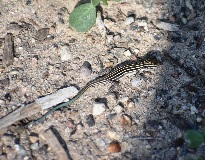Little Striped Whiptail (Aspidoscelis inornatus)
Description: The little striped whiptail grows from 6.5 to 9.5 inches in length. It is typically black in color, with yellow or white striping from head to tail, and a light blue underside. It is slender bodied, with a blue colored tail approximately three times the body length. The blue coloration is much more pronounced on males than females. They aren't always striped or blue, sometimes they are brown with darker patches to blend in with the sand or dirt.
Habitat: They are found in a range of habitats, from grasslands to semi-arid rocky slopes.
Range: the range includes Arizona, New Mexico, western Texas (United States), and northern central Mexico (south to Zacatecas and San Luis Potosi).
Found in these States:
AZ |
NM |
TX
Diet: Eats insects, spiders, and centipedes.
Reproduction: Breeding takes place in the late spring, and clutches of 2 to 4 eggs are laid from May to July and hatch approximately six weeks later. Clutch size is 1-5 (usually 2-3). May produce more than one clutch annually in most areas (only 1 at high elevations in central Arizona). In central Arizona, yearling females are not sexually mature, hatchlings appear in mid-August
Status: Listed as Least Concern in view of its wide distribution, many locations, and presumed large population size, and because it is unlikely to be declining fast enough to warrant listing in a more threatened category. Habitat degradation is a conservation concern in some areas.
Subspecies: Ten, with just 3 found in our range:
Arizona Striped Whiptail - (Aspidoscelis inornatus arizonae)
Chihuahua Striped Whiptail - (Aspidoscelis inornatus chihuahuae)
Cuatro Cienegas Whiptail - (Aspidoscelis inornatus cienegae)
Little White Whiptail - (Aspidoscelis inornatus gypsi)
Trans-Pecos Striped Whiptail - (Aspidoscelis inornatus heptagrammus)
Little Striped Whiptail - (Aspidoscelis inornatus inornatus)
Woodland Striped Whiptail - (Aspidoscelis inornatus juniperus)
Plains Striped Whiptail - (Aspidoscelis inornatus llanuras)
No Common Name - (Aspidoscelis inornatus octolineatus)
Mexican Little Striped Whiptail - (Aspidoscelis inornatus paululus)
This article uses material from the Wikipedia article "Little Striped Whiptail", which is released under the Creative Commons Attribution-Share-Alike License 3.0. Content may have been omitted from the original, but no content has been changed or extended.
|








